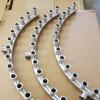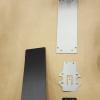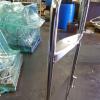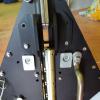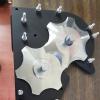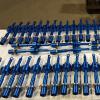ANODIC COATINGS FOR ALUMINUM AND ALUMINUM ALLOYS
This specification is the model for much of the anodizing specified for military and aerospace products. MIL-A-8625 also forms the basis for many anodizing specifications that are proprietary to individual companies. Nearly all of these proprietary specifications refer to one or more requirements of this mil spec.
The specification includes broad processing conditions for anodizing. It also gives important performance and acceptance criteria for such attributes as coating weight, corrosion resistance, light fastness, paint adhesion, abrasion resistance, and dying.
Coating types and classes at ACE Plating are:
Type II: Sulfuric acid anodizing (conventional)
Type III: Hard anodize
Class 1: Non-dyed
Class 2: Dyed (Black)
© 2010 Company Name. All rights reserved.
Passivation of Stainless Steel – ASTM A967, AMS 2700 & QQ-P-35
Passivation of stainless steel is a process that removes free iron from the surface of a stainless component and at the same time promotes the formation of a thin dense oxide protective barrier.
Passivation of Stainless Steel Specifications:
ASTM A967
AMS 2700
QQ-P-35
ASTM 380
ASTM A 967-05 Specifications:
Nitric Acid Methods:
Citric Acid Methods:
QQ-P-35C/AMS-QQ-P-35A Specifications:
Passivation Types:
AMS 2700C Specifications:
1
Passivation Types:
Method 1
1 Method 1-Passivation in Nitric Acid; Method 2-Passivation in Citric Acid
Method 2 Citric Acid
BUSINESS HOURS
Monday-Friday 8:00am-4:00pm
Saturday-Sunday CLOSED
ACE PLATING LLC.
• Nitric 1: 20-25 v% Nitric Acid, 2.5 w% Sodium Dichromate, 120-130° F, 20 minutes minimum
• Nitric 2: 20-45 v% Nitric Acid, 70-90°F, 30 minutes minimum
• Nitric 3: 20-25 v% Nitric Acid, 120-140°F, 20 minutes minimum
• Nitric 4: 45-55 v% Nitric Acid, 120-130°F, 30 minutes minimum
• Nitric 5: Other combinations of temperature, time and with or without accelerants, inhibitors or proprietary solutions capable of producing parts that pass the specified test requirements.
• Citric 1: 4-10 w% Citric Acid, 140-160°F, 4 minutes minimum
• Citric 2: 4-10 w% Citric Acid, 120-140°F, 10 minutes minimum
• Citric 3: 4-10 w% Citric Acid, 70-120°F, 20 minutes minimum
• Citric 4: Other combinations of temperature, time and concentration of citric acid with or without chemicals to enhance cleaning, accelerants or inhibitors capable of producing parts that pass the specified test requirements.
• Citric 5: Other combinations of temperature, time and concentration of citric acid with or without chemicals to enhance cleaning, accelerants or inhibitors capable of producing parts that pass the specified test requirements. Immersion bath to be controlled at pH of 1.8-2.2
708 Pulaski Highway Suite:B, Joppa, Maryland 21085 Email: scott@aceplatingllc.com Office: (410) 676-1515
• Type I: - Withdrawn
• Type II: 20-25 v% Nitric, 2-2.5 w% Sodium Dichromate, 120-130°F, 20 minutes minimum
• Type III: - Withdrawn
• Type IV: - Withdrawn
• Type V: - Withdrawn
• Type VI: 25-45 v% Nitric, 70-90°F, 30 minutes minimum
• Type VII: 20-25 v% Nitric, 120-150°F, 20 minutes minimum
• Type VIII: 45-55 v% Nitric, 120-130°F, 30 minutes minimum
• Type 1: 20-25 v% Nitric Acid, 2-3 w% Sodium Dichromate, 70-90°F, 30 minutes minimum
• Type 2: 20-25 v% Nitric Acid, 2-3 w% Sodium Dichromate, 120-130°F, 20 minutes minimum
• Type 3: 20-25 v% Nitric Acid, 2-3 w% Sodium Dichromate, 145-155°F, 10 minutes minimum
• Type 4: 38-42 v% Nitric Acid, 2-3 w% Sodium Dichromate, 70-120°F, 30 minutes minimum
• Type 5: 20-25 v% Nitric Acid, 2-3 w% Sodium Dichromate, 70-90°F, 2 minutes minimum, Part anodic at 3-5 volts (not done at AST)
• Type 6: 25-45 v% Nitric Acid, 70-90°F, 30 minutes minimum
• Type 7: 20-25 v% Nitric Acid, 120-140°F, 20 minutes minimum
• Type 8: 45-55 v% Nitric Acid, 120-130°F, 30 minutes minimum
Electropolishing - ASTM B912
Electropolishing, n--electrochemical process in which the article(s) to be passivated are treated anodically in a suitable acid medium.
The electropolishing process is often used as a more aggressive alternative to passivation (per ASTM B912 and ASTM A967) and does not require a separate treatment for passivation. Since the process removes the outer skin of metal, embedded contaminants which can cause sub-surface corrosion are eliminated. The electropolished part is left in a homogenous and passive condition which offers superior corrosion resistance to chemical passivation.
Passivation of Stainless Steels Using Electropolishing
This specification covers the passivation of steel alloys in the 200 (UNS2XXXX), 300 (UNS3XXXX) and 400 (UNS4XXXX) series, and the precipitation-hardened alloys, using electropolishing procedures.
A380
Standard Practice for Cleaning, Descaling, and Passivation of Stainless Steel Parts, Equipment, and Systems.
Black Oxide - MIL-DTL-13924, MIL-F-495
The black oxide process can be applied to many diverse metals including: carbon, alloy and stainless steels, copper, brass, bronze, die cast zinc, and cast iron.
MIL-DTL-13924 SPECIFICATION:
COATING, OXIDE, BLACK, FOR FERROUS METALS (18 MAR 1999) [SUPERSEDING MIL-C-13924C]., This specification covers black oxide coatings applied to ferrous metals (wrought iron, carbon, low alloy, and corrosion resistant steels). Black oxide coatings, with or without a supplementary preservative treatment, may be used where a black surface is required. Only very limited corrosion protection, under mildly corrosive conditions, is obtained as a result of black oxide coating.
• Class 1: Alkaline oxidizing process ( for wrought iron, cast and malleable irons, plain CARBON, and low alloy steels).
• Class 4: Alkaline oxidizing process ( for other corrosion resistant steel alloys, STAINLESS STEEL ).
MIL-F-495 SPECIFICATION: A uniform black corrosion retarding coating for copper & copper alloys.
Aluminum Chromate Conversion Coating
( IRIDITE ) MIL-F-14072, MIL-C-5541 & (MIL-DTL-5541)
• Type I: Compositions containing hexavalent chromium.
A chemical process that produces a protective chromate conversion film on aluminum and aluminum alloys. Application is by dip, brush, swab, or spray, producing coatings ranging from clear to dark yellow. The darker coatings providing the greatest corrosion protection.
• Class 1A: For maximum protection against corrosion, painted or unpainted.
• Class 3: For protection against corrosion where low electrical resistance is required.
• Type II: Compositions containing NO hexavalent chromium. (RoHS)
A chemical process that produces a protective chromate conversion film on aluminum and aluminum alloys. Application is by dip, brush, swab, or spray, producing coatings ranging from clear to gray.
• Class 1A: For maximum protection against corrosion, painted or unpainted.
• Class 3: For protection against corrosion where low electrical resistance is required.
MIL-DTL-5541 Type II, Class 1A & 3 (RoHS Compliant)
Anodizing - MIL-A-8625
Type 3:
This specification covers the requirements for an electrochemical process for building a lubricative anodic coating on aluminum and aluminum alloys. The unsealed anodic coating is impregnated with polytetrafluoroethylene (PTFE) or coated with a resin-bonded materials containing PTFE.
MIL-A-63576
